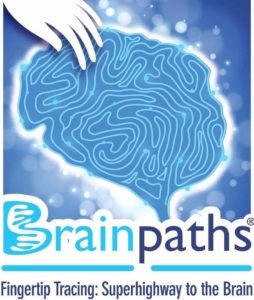Instructions For Use
 |
Brainpaths Fingertip Tracing:Improves Memory Strengthens Synapse ConnectionsSensory stimulation and repetitious mind exercises resulting from repetitive fingertip movement, improves memory & cognitive abilities, relieves anxiety, depression and stress. |
 |
BRAINPATHS INSTRUCTIONS:
USING REPETITIVE, STRONG STROKES, TO FIRE AND WIRE NEURONS IN THE BRAIN TO FORM NETWORKS OF NEURONS WORKING TOGETHER TO KEEP YOUR BRAIN HEALTHY.
Trace with one fingertip:
Use one fingertip to trace the design on the front side of your device. Find the beginning point and ending point and trace as many times as desired.
Trace with ten fingertips:
To repeatedly trace your device with all ten fingertips, place your thumbs along the outside edge of the design-side of the device and all eight fingertips on the backside of the device. You will be tracing the outer edge of each side of the device. Be sure to indent each fingertip into textures to receive the strongest brain stimulation.
Design tracing with one fingertip:
To trace the design, find the beginning and ending points. Sometimes they are together and sometimes begin and end at different areas. Start tracing the pathway with one fingertip, moving along in a continuous pathway from the beginning to the end. You many time yourself to see how long it takes from beginning to end.
Design tracing a Labyrinth:
A design with a continuous pathway called a Labyrinth. A labyrinth is less challenging but provides strong brain stimulation by touching 3000 mechanoreceptors in each fingertip.
Design tracing a Maze:
Some Brainpaths devices have more complex designs that have pathways that end some where in the middle, forcing the user to move backward and find the correct pathway that continues to the end of the design. A design that has multiple pathways that end along the path is called a Maze.
A Maze can be frustrating as the user struggles to find the correct pathway to reach the end. A maze provides excellent brain stimulation but it is not meant for everyone.
Choose a Design that fits your needs:
Both designs are interesting and may be used for brain stimulation. However, if you find the maze is too challenging, choose labyrinths instead.
Suggested Time for Using Brainpaths:
A suggested time period for tracing is 10-20 minutes for each session. Consult with your doctor regarding the number of sessions to be used each day.
When and Where Should You Use Brainpaths:
Tracing Brainpaths devices can be in the morning, noon, evening, before bed, waking up, waiting for an appointment or sitting in the spa. Tracing can be done as you listen to music, watch TV or sit quietly in your own space.
BACKGROUND INFORMATION: Brainpaths devices are neurosurgical medical devices, registered and listed by the Federal Drug Administration (FDA). Brainpaths is conducting studies, but Braille research has been ongoing for decades. We ask you to try Brainpaths and share your experiences with us, or go to Facebook and Twitter Brainpaths sites and share your experiences. Others are waiting to hear your story.
How Does Brainpaths Work: Repeatedly tracing textures injected into the surface of the device, indents into the users fingertips to reach 3000 mechanoreceptors in each fingertip, providing a ‘superhighway from the fingertips to the spinal column and then to the sensory cortex of the brain to provide strong brain stimulation.
RESEARCH justifies tracing a design with one fingertip for strong brain stimulation:
Research by Dr. Ester P. Gardner, “Coding of Sensory Information”, discloses mechanoreceptors are activated by strong stimuli: sharp, pricking sensations. Pinching the skin with a two-sided probe (such as tweezers) produces the strongest response. Brainpaths devices have textures that provide sharp pricking sensations as the textures indent into users fingertips. Take a minute to trace an area of the design, strongly indenting into the pathway. Now look at the indentions in your fingertip. You can easily see how the indentions “pinch the skin” like the two sided probe, researched by Dr. Gardner in “Coding of Sensory Information”, providing strong stimulation to the brain while tracing.

Diagram shows the strongest stimulation results using a two-sided probe (shown above in: C Pinch). This effect is attained using the two sided textures injected into Brainpaths devices.
